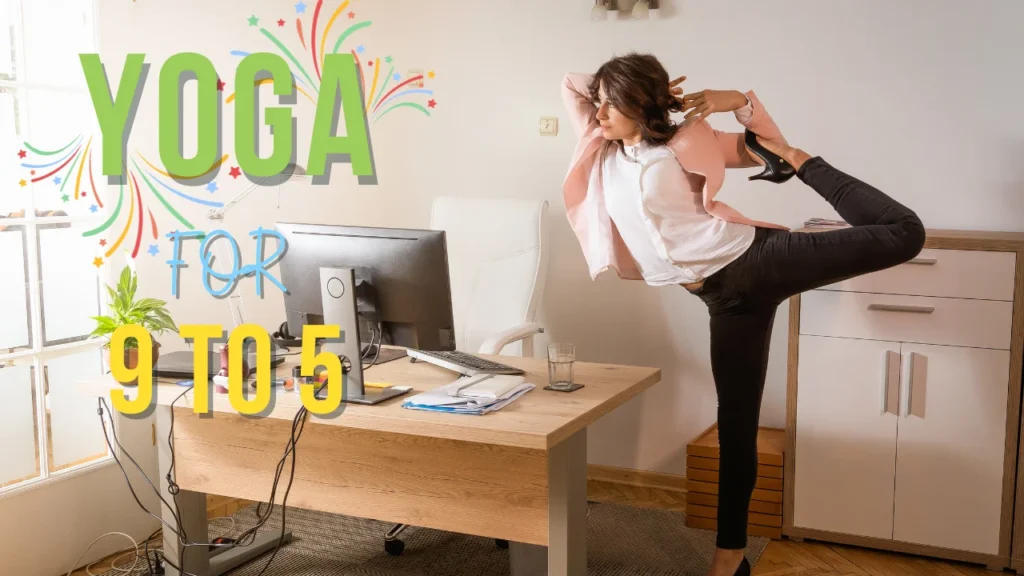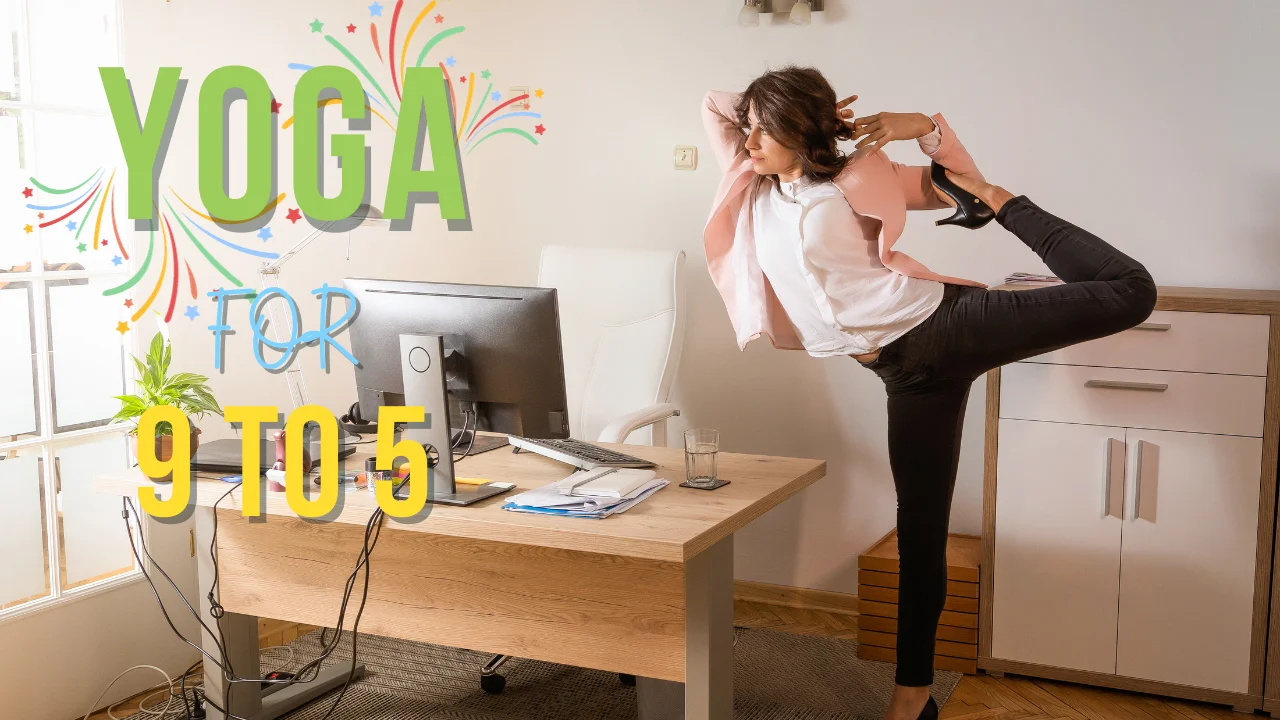Yoga For 9 to5 People

In the hustle and bustle of our daily life. yoga for 9 to 5 office people becomes lifesaver. Why? Let me explain, 9 to 5 people work in a place where deadlines loom and stress can often take center stage, finding a moment of tranquility and rejuvenation is not just a luxury but a necessity. Enter yoga – a holistic practice that transcends the boundaries of time constraints and office walls, offering a pathway to better health, improved focus, and a more balanced life.
For the dedicated office dweller, yoga is not merely a series of poses; it’s a transformative journey that can be seamlessly integrated into your daily routine. Whether you’re confined to a desk for hours or navigating the challenges of a demanding schedule, the art of yoga brings with it a myriad of benefits tailored to the unique needs of the 9-to-5 workforce.
Table of Contents
Imagine a world where stress is met with deep, intentional breaths; where the tension accumulated from hours of sitting dissolves with each purposeful stretch. Yoga is your ticket to this world, a sanctuary of mindfulness amidst the demands of your workday.
By joining yoga activities, you’re not just participating in a physical practice – you’re embracing a holistic approach to well-being. Yoga empowers you to foster a connection between mind and body, providing a toolkit of poses and techniques designed to alleviate the strains of sedentary work, improve posture, and enhance mental clarity.
So, why wait? Take that first step onto the yoga mat, and let the ancient wisdom of this practice guide you toward a healthier, more harmonious existence. Your body and mind will thank you, and your 9-to-5 routine may just transform into a journey of well-being and vitality. Welcome to the world of yoga – where the benefits stretch far beyond the mat and into the heart of your daily life.
Best Health tips to blend with Yoga and Improves Heart Health

Yoga has been associated with several health benefits, and there is evidence to suggest that it can positively impact heart function. Here are some ways in which yoga may contribute to improved heart health:
1. Stress Reduction:
One of the key benefits of yoga is its ability to reduce stress. Chronic stress can contribute to cardiovascular problems. Yoga incorporates techniques such as deep breathing, meditation, and mindfulness, which can help activate the body’s relaxation response, reduce stress hormones, and promote a sense of calm. Lowering stress levels can have a positive impact on heart health.
2. Lowering Blood Pressure:
Some studies have indicated that practicing yoga regularly may lead to a reduction in blood pressure. This is important for heart health, as high blood pressure is a risk factor for cardiovascular diseases.
3. Improving Cardiovascular Fitness:
Certain types of yoga, such as vinyasa or power yoga, can provide a cardiovascular workout. These more active forms of yoga can elevate the heart rate, improve circulation, and contribute to better cardiovascular fitness over time.
4. Enhancing Respiratory Function:
Yoga emphasizes conscious and controlled breathing techniques. Practicing deep, diaphragmatic breathing can improve lung capacity and efficiency, leading to better oxygenation of the blood and improved cardiovascular function.
5. Increasing Flexibility and Balance:
While not directly related to the heart, improving overall physical fitness through yoga can contribute to better cardiovascular health. Increased flexibility and balance can make everyday activities easier and may encourage more physical activity, which is beneficial for the heart.
6. Weight Management:
Regular yoga practice, combined with a healthy lifestyle, may contribute to weight management. Maintaining a healthy weight is crucial for heart health, as obesity is a risk factor for cardiovascular diseases.
7. Promoting Overall Well-being:
Yoga is a holistic practice that addresses physical, mental, and emotional well-being. Improved mental health, reduced anxiety, and better sleep can indirectly contribute to heart health.
It’s important to note that while yoga can be a valuable component of a heart-healthy lifestyle, it should not be considered a substitute for other important factors such as a balanced diet, regular exercise, and medical care when needed. Before starting any new exercise program, including yoga, it’s advisable to consult with a healthcare professional, especially if you have any existing health concerns.
Yoga for 9 to 5 Office People

Incorporating yoga into a busy work schedule can be challenging, but with some planning and commitment, it’s definitely possible. Here are some tips to help you add yoga to your daily routine, even with a 9-to-5 office job:
Set Realistic Goals:
Start with realistic expectations. You don’t need to commit to long sessions every day. Even a short 15-20 minute session can be beneficial.
Morning or Evening Routine:
Consider incorporating yoga into your morning or evening routine. A short session in the morning can help you start the day with energy and focus, while an evening session can help you unwind and relax.
Lunch Break Yoga:
Use part of your lunch break for a quick yoga session. You can find short routines online or use apps that offer guided sessions for various durations.
Desk Yoga:
Incorporate simple yoga stretches into your workday, especially if you have a sedentary job. Stretch your arms, neck, and back periodically. Simple seated stretches or chair yoga poses can be done discreetly at your desk.
Choose the Right Type of Yoga:
Select a style of yoga that suits your schedule and energy levels. Gentle yoga, Hatha yoga, or restorative yoga can be good choices for beginners and those with busy lifestyles.
Use Apps or Online Videos:
There are many apps and online platforms that offer short and focused yoga sessions. These can be convenient for busy individuals, allowing you to practice at home or in a quiet space at work.
Join a Yoga Class:
If possible, find a local yoga class that fits your schedule. Some studios offer early morning or evening classes that can accommodate office hours.
Create a Dedicated Space:
Designate a quiet and comfortable space at home for your yoga practice. Having a dedicated space can help create a routine and make it easier to commit to regular practice.
Involve Colleagues:
Encourage colleagues to join you for a short yoga session during breaks. This can create a supportive environment and make it more enjoyable.
Be Flexible:
Recognize that some days will be busier than others. Be flexible with your yoga routine and find ways to incorporate shorter sessions or mindfulness practices when time is limited.
Remember, consistency is key. Start with small steps and gradually increase the duration and intensity of your practice as you become more comfortable. Listen to your body and choose a routine that aligns with your energy levels and schedule.
Best Yoga Poses for 9 to 5 Office People

For individuals with a 9-to-5 work schedule, incorporating yoga poses that address common issues associated with office work, such as prolonged sitting and potential muscle tension, can be beneficial. Here are some yoga poses that are particularly well-suited for people with desk jobs:
Seated Cat-Cow Stretch:
Sit on the edge of your chair with your feet flat on the floor. Inhale, arch your back, and lift your chest (Cow Pose). Exhale, round your spine, and bring your chin to your chest (Cat Pose). Repeat several times to release tension in the spine.
Chair Pigeon Pose:
While seated, cross your right ankle over your left knee, keeping the right knee open to the side. Sit up tall and gently lean forward to feel a stretch in the outer hip. Repeat on the other side.
Seated Forward Fold:
Sit with your legs extended in front of you. Inhale to lengthen your spine, then exhale and hinge at your hips to reach forward toward your toes. This pose stretches the hamstrings and helps release tension in the lower back.
Eagle Arms:
While seated or standing, extend your arms in front of you. Cross your right arm over your left, then bend your elbows and bring your palms together. Lift your elbows and relax your shoulders. This pose helps relieve tension in the upper back and shoulders.
Standing Forward Fold:
Stand with your feet hip-width apart. Inhale to reach your arms overhead, and then exhale to fold forward, reaching toward the floor or your shins. This pose stretches the entire back and helps release tension in the spine.
Desk Shoulder Opener:
Stand with your feet hip-width apart. Place your hands on your desk, walk back, and hinge at your hips. Drop your chest toward the floor, allowing your shoulders to open and your head to hang. This is a great stretch for the shoulders and upper back.
Wrist and Forearm Stretch:
Extend your arms in front of you at shoulder height. Rotate your wrists clockwise and counterclockwise to loosen them. Gently stretch your wrists and forearms by pressing your palms together, fingers pointing up.
Child’s Pose:
Kneel on the floor, sit back on your heels, and then reach your arms forward on the floor. Rest your forehead on the ground. This pose is a great way to stretch the back, hips, and shoulders.
Legs Up the Wall Pose:
Sit with your side against a wall and swing your legs up, resting them against the wall. This pose can help reduce swelling in the legs, alleviate lower back discomfort, and promote relaxation.
Corpse Pose (Savasana):
Lie on your back, legs extended, and arms by your sides. Close your eyes and focus on your breath. This pose is a relaxation pose and can help reduce stress and promote a sense of calm.
Remember to listen to your body and modify these poses as needed. Even taking short breaks throughout the day to stretch and move can make a significant difference in how you feel physically and mentally during and after work.
Read More Articles on Health From our Health Section : Lets Go
- 10 Best Ways Avoid Back pain. Causes, Treatment , And Poses For Back pain Relief
- How Over Exercising can lead to Heart Attack! 6 Ways to Avoid Heart Attack during Exercise.
- 10 Proven and Effective Ways To Reduce Stress
- 20 ways, How Yoga can Improve your Heart Function; Exercises and Poses for 9 to 5 People
- 3 Proven Ways to Get Out of Anxiety: A Simple Guide for Better Life






